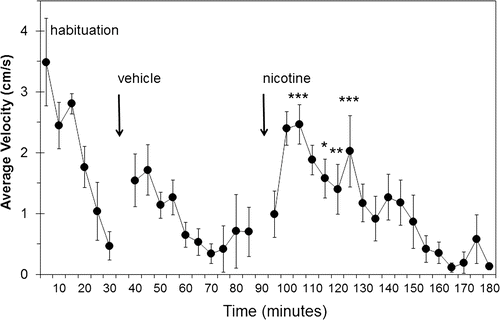Figures & data
Figure 1. Spontaneous locomotor activity of rats following no treatment (habituation), or s.c. injections of vehicle or nicotine. Drug-naive rats were monitored in the spontaneous activity chamber for 30 min to determine the time course of habituation (habituation). Immediately afterward, each rat was injected s.c. with vehicle and monitored for 50 min (vehicle). Finally, each rat was injected s.c. with 0.4 mg/kg nicotine and monitored for another 90 min (nicotine). Data shown are the average ± standard error of the mean (SEM) of the mean velocity of each rat over each 5 min period of monitoring (n = 6). Gaps at 30–35 min and 90–95 min were due to interruption of data collection when animals were removed from the chambers for injection. Significant differences were determined by analysis of variance by time point, with comparisons among the four treatment groups made by 2-way analysis of variance followed by Bonferroni’s multiple comparison test. *p < 0.05, **p < 0.01, ***p < 0.001 indicate time intervals at which nicotine was different from vehicle at the same time interval after the initiation of the respective phase of the experiment; that is, starting at 40 min for vehicle and at 95 min for nicotine.

Figure 2. Spontaneous locomotor activity of rats on the day of the pretreatment and nicotine challenge (day 5). Separate groups of 8–10 rats were treated once/day for four days (Days 1–4) with 0.4 mg/kg nicotine or vehicle. On day 5, each rat was monitored for spontaneous activity for approximately 25 min before i.p. pretreatment with passion flower or vehicle, and were then monitored for another 25 min before receiving an s.c. challenge dose of nicotine. Data shown are the average ± SEM of the mean velocity of each rat over each 5 min period of monitoring. Gaps at 20–25 min and 45–50 min were due to interruption of data collection when animals were removed from the chambers for injection. Significant differences between groups were determined by analysis of variance by time point, with comparisons among the four treatment groups made by Tukey’s multiple comparison procedure. *p < 0.05, **p < 0.01 indicates at each time point when the activity of the groups was different from each other. The nicotine-vehicle group was the only one that was different from any of the others at any time point.
